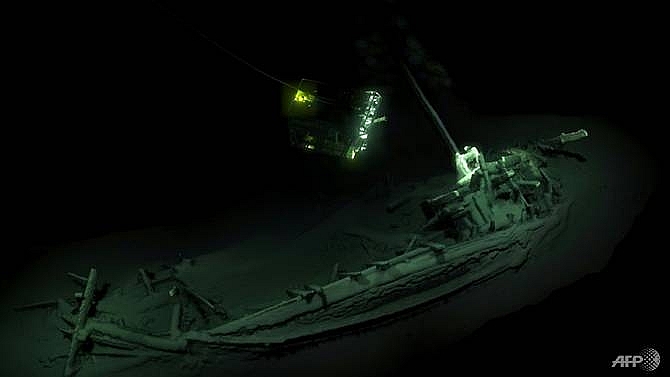World's oldest intact shipwreck from 2,400 years ago found in Black Sea
 |
| An undated picture released by Black Sea MAP/EEF Expeditions in London on October 23, 2018 shows the remains of an ancient Greek trading ship lying on the sea bed at the bottom of the Black Sea near Bulgaria AFP/HO |
The vessel is one of more than 60 shipwrecks identified by the Black Sea Maritime Archaeology Project including Roman ships and a 17th-century Cossack raiding fleet.
During the three-year project, researchers used specialist remote deep-water camera systems previously used in offshore oil and gas exploration to map the sea floor.
"A small piece of the vessel has been carbon dated and it is confirmed as the oldest intact shipwreck known to mankind," the project said in a statement.
The ship, which is lying on its side with its mast and rudders intact, was dated back to 400 BC - a time when the Black Sea was a trading hub filled with Greek colonies.
The team said the vessel, previously only seen in an intact state on the side of ancient Greek pottery, was found at a depth of more than 2,000 metres.
The water at that depth is oxygen-free, meaning that organic material can be preserved for thousands of years.
"A ship, surviving intact, from the Classical world, lying in over 2km of water, is something I would never have believed possible," said Professor Jon Adams from the University of Southampton in southern England, the project's main investigator.
"This will change our understanding of shipbuilding and seafaring in the ancient world," he said.
Helen Farr, a project team member, said: "We have bits of shipwreck which are earlier but this one really looks intact."
"The project as a whole was actually looking at sea level change and the flooding of the Black Sea region ... and the shipwrecks are a happy by-product of that," she told BBC radio.
What the stars mean:
★ Poor ★ ★ Promising ★★★ Good ★★★★ Very good ★★★★★ Exceptional
Related Contents
Latest News
More News
- 72 nations sign landmark Hanoi cybercrime convention (October 26, 2025 | 18:00)
- UN Secretary-General commends Vietnam’s global leadership (October 26, 2025 | 09:00)
- APEC finance ministers convene to tackle regional challenges (October 22, 2025 | 17:31)
- Rewiring global trade: ASEAN’s rise as supply chain hub (October 17, 2025 | 11:40)
- Vietnam attends first World Nuclear Week Forum in Russia (September 26, 2025 | 10:50)
- Vietnam attends 69th session of IAEA General Conference (September 16, 2025 | 10:00)
- ADB, WB pledge over 12 billion USD for ASEAN power grid, renewable energy projects (August 15, 2025 | 14:18)
- Lowy Institute proposes AI-based tobacco control solutions for ASEAN (August 15, 2025 | 14:14)
- Cloud computing policy to position Malaysia as regional hub by 2030 (August 15, 2025 | 14:11)
- Thailand, Cambodia suffer numerous cyber attacks (August 05, 2025 | 16:19)

 Tag:
Tag:





















 Mobile Version
Mobile Version